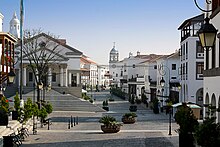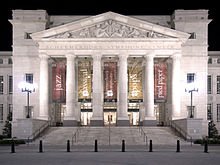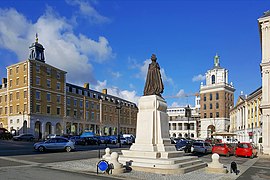New Classical architecture

New Classical architecture, also known as New Classicism or Contemporary Classical architecture,[1] is a contemporary movement that builds upon the principles of Classical architecture. It is sometimes considered the modern continuation of Neoclassical architecture,[2][3][4] even though other styles might be cited as well, such as Gothic, Baroque, Renaissance or even non-Western styles[5] – often referenced and recreated from a postmodern perspective rather than as strict revivals.[6]
The design and construction of buildings in evolving classical styles continued throughout the 20th and 21st centuries, even as modernist and other non-classical theories broke with the classical language of architecture. The New Classical movement is also tied to a resurgence in new traditional architecture, which emphasizes craftsmanship rooted in local building traditions and materials.[7]
Development
[edit]
During the 1950s and 1960s, a small group of architects in Europe continued designing classical buildings contrary to the prevailing fashion for Modernist architecture. British architects Donald McMorran, who designed several noteworthy neoclassical buildings such as the Cripps Hall at the University of Nottingham and described the Modernist movement as "a dictatorship of taste",[8][9] and Raymond Erith, who mentored New Classical architect Quinlan Terry – Erith's pupil, employee, partner, and ultimately successor – were notable for their neoclassical works, including numerous civic buildings and housing estates. In mainland Europe, François Spoerry contributed to the European Urban Renaissance with his classical designs and by the late 1970s, architects like Leon Krier and Maurice Culot began challenging modernist planning through publications and counter-projects,[10] a movement further bolstered by the support of King Charles III (then Prince of Wales) and initiatives such as The Prince's Foundation for Building Community.[11]

During the same period, postmodern architecture emerged as a critique tp modernist architectural aesthetics.[12] Influential architects inside this movement, such as Charles Moore, Robert Venturi,[13] and Michael Graves used classical elements as ironic motifs to criticize modernism's sterility. A broad spectrum of more than two dozen architects, theorists, and historians also presented alternatives to modernism[14] and among them were several serious New Classical architects who viewed classicism as a legitimate mode of architectural expression, some of whom would later become Driehaus Prize Laureates, including figures like Thomas Beeby and Robert A.M. Stern, who practiced both postmodern and classical styles. Some postmodernist firms, such as Stern and Albert, Righter, & Tittman, outright transitioned from postmodern design to new interpretations of traditional architecture.[12]
On the education front, Thomas Gordon Smith, a Rome Prize laureate from the American Academy in Rome, published Classical Architecture: Rule and Invention in 1988 and was appointed to chair the University of Notre Dame's Department of Architecture a year later, structuring the curriculum around classical and traditional building practices.[15][16] Today, programs that teach New Classical Architecture are offered at the University of Miami, Judson University, Andrews University and the Center for Advanced Research in Traditional Architecture in Traditional Architecture at the University of Colorado Denver.[17]
The New Classical movement continues to develop at the professional and popular level, gaining momentum after the 1963 demolition of McKim, Mead & White's Pennsylvania Railroad Station in New York City, which led to the formation of Classical America. Led by Henry Hope Reed, Jr.,[18] which advocated for the appreciation of classical architecture by teaching architects the classical orders and hosting various events and conferences.[19] In 2002, the Institute of Classical Architecture merged with Classical America to form the Institute of Classical Architecture & Art (ICAA), which supports regional chapters in the United States that host awards programs,[20] publishes the peer-reviewed journal The Classicist,[21] and offers educational programs for professionals and the public.[22] The international expansion of the movement was catalyzed by the creation of the International Network for Traditional Building, Architecture & Urbanism (INTBAU) in 2001[23], a global organization under the patronage of King Charles III,[24] focused on supporting traditional architecture and preserving local character.[25]
In 2003, philanthropist Richard H. Driehaus established the Driehaus Architecture Prize, awarded by the University of Notre Dame School of Architecture, to honor architects whose work embodies classical and traditional principles in architecture and urbanism, seen as the alternative to the modernist Pritzker Prize, but with double the cash prize.[26] It is awarded along side the Reed Award which recognizes individuals outside architecture who support traditional city design through writing, planning, or promotion.[27] Other notable classical architecture awards include the American Palladio Award,[28] the European Philippe Rotthier Prize,[29] the Iberian Rafael Manzano Prize,[30] the Edmund N. Bacon Prize,[31] and the Rieger Graham Prize[32] of the Institute of Classical Architecture and Art (ICAA) for architecture graduates.
Since 2014, the "Arkitekturupprororet" (Architectural Uprising) movement in Sweden has advocated for traditional designs in new developments.[33] Originally a Facebook group, it has expanded to other Nordic countries and the rest of the world,[34] achieving moderate success in promoting traditional architecture.[33] The movement's main goal is to "make architecture available to everyone"[33] through social media and annual awards recognizing the best and worst new buildings in Sweden.
In 2021, efforts to reintroduce New Classical architecture into urban planning were furthered in the U.S. by architect Nir Buras,[35] who founded the Classic Planning Institute (CPI). Based in Washington, D.C., the CPI focuses on research, practice, and education to incorporate New Classical principles into contemporary urban planning. The CPI also hosts the Traditional Architecture Gathering (TAG),[36] an international conference that attracts hundred of architects and enthusiasts to discuss New Classical Architecture worldwide.
Philosophy
[edit]
New Classical professionals tend to work under the assumption that there is no such thing as purely original creation, and that innovation unavoidably occurs in an environment laden with suggestions, influences, a precedent of problems solved and, perhaps more importantly, mistakes to be avoided.[37]
Many New Classical architects believe in the importance of sustainability, and aim to create long-lasting, well-crafted buildings of great quality, adapted to the context and with an efficient use of natural resources.[38]
Educational institutions
[edit]While most universities worldwide teach modernist design principles, some institutions teach (solely, mainly, or partly) the principles of traditional and classical architecture and urban planning. Some of these are:[39]
- Brazil
- Centro Universitário Euroamericano (UNIEURO), in Brasília.[40]
- India
- Tirumala S.V. Institute of Traditional Sculpture and Architecture (SVITSA), in Tirupati, Andhra Pradesh.[41]
- Italy
- New Zealand
- United Kingdom
- National Design Academy, in Nottingham (heritage interior design).[43]
- The Prince's Foundation for Building Community, in London.
- The Prince's School of Traditional Arts, in London.
- Unit 6 of the Kingston School of Art's Master of Architecture program,[44] the only postgraduate unit in the United Kingdom to teach classical design. Previously, this was taught in the undergraduate program.
- University of Portsmouth, in Portsmouth, School of Architecture.[45]
- PRASADA – Practice, Research, and Advancement in South Asian Design and Architecture at Welsh School of Architecture, Cardiff University, in Cardiff, Wales.
- United States
- Andrews University, in Berrien Springs, Michigan.[46]
- American College of the Building Arts.[47] and School of the Arts at College of Charleston, in Charleston, South Carolina.
- The Center for Advanced Research in Traditional Architecture at the University of Colorado, in Denver, Colorado.
- University of Miami, in Coral Gables, Florida.[48]
- Yale School of Architecture, in New Haven, Connecticut.[49]
- Grand Central Academy of Art formerly hosted at the Institute of Classical Architecture & Art (ICAA), in New York City, New York.
- Institute of Classical Architecture & Art (ICAA), in New York City, New York.
- University of Notre Dame School of Architecture, in Notre Dame, Indiana.
- Utah Valley University, in Orem, Utah.[50]
- Beaux-Arts Academy, in Salt Lake City, Utah.[51]
- Academy of Classical Design, in Southern Pines, North Carolina.
- The Classic Planning Institute, Washington D.C.
Examples
[edit]-
Richmond Riverside, London, England, 1984–87, by Quinlan Terry
-
Poundbury, England, 1993, by Léon Krier
-
Garden Pavilion at Edgewater, 1997, by Michael Dwyer
-
Royal Air Force Bomber Command Memorial, London, England, 2012, by Liam O'Connor
See also
[edit]- Complementary architecture
- Revivalism (architecture)
- Classical Realism
- Driehaus Architecture Prize
- Traditional architecture
- Outline of classical architecture
References
[edit]- ^ Giuseppe Amoruso, ed. (2018). Putting tradition into practice: heritage, place and design: proceedings of 5th INTBAU International Annual Event. Cham: Springer. ISBN 978-3-319-57937-5. OCLC 1000578629.
- ^ Machalinski, Anne (16 March 2020). "Classical Contemporary Meets the Future". www.mansionglobal.com. Retrieved 2021-01-12.
- ^ Curl, James Stevens (2006). A dictionary of architecture and landscape architecture (2nd ed.). Oxford [England]: Oxford University Press. ISBN 978-0-19-280630-7. OCLC 64585874.
- ^ Curl, James Stevens; Wilson, Susan (2015). "New Classicism". The Oxford Dictionary of Architecture. Oxford University Press. pp. 520–522. ISBN 978-0-19-967498-5.
- ^ "6 Classical Buildings That Are Younger Than You Think". ArchDaily. 2015-04-19. Retrieved 2021-02-18.
- ^ Jencks, Charles (1987). Post Modernism: The New Classicism in Art and Architecture. New York: Rizzoli. pp. 7–8. ISBN 0-85670-867-4.
- ^ Quigley, Kathleen (7 August 2018). "Inside Architecture's New Classicism Boom". Architectural Digest. Retrieved 2019-02-16.
- ^ "Central Criminal Court Extension, London – The Twentieth Century Society". c20society.org.uk. Retrieved 9 December 2021.
- ^ Curl, James Stevens, ed. (2006). Oxford Dictionary of Architecture and Landscape Architecture. Oxford University Press. pp. 466–7. ISBN 978-0-19-860678-9. Retrieved 3 December 2021.
- ^ Leon Krier and Maurice Culot, "Counterprojets: Prefaces," (Brussels: Archives d'Architecture Moderne, 1980).
- ^ Charles, Prince of Wales, "A Vision of Britain: A Personal View of Architecture," (New York: Doubleday, 1989).
- ^ a b McAlester, Virginia Savage (2013). A Field Guide to American Houses. Alfred A. Knopf. pp. 664–665, 668–669. ISBN 978-1-4000-4359-0.
- ^ Robert Venturi, "Complexity and Contradiction in Architecture," (New York: Museum of Modern Art, 1966).
- ^ Andreas Papadakis and Harriet Watson, eds., "New Classicism: Omnibus Volume," (London: Academy Editions, 1990).
- ^ "Many Canons, Many Conversions -". blogs.nd.edu. Archived from the original on 29 October 2013. Retrieved 3 May 2018.
- ^ Gunts, Edward (2021-07-01). "Notre Dame's Thomas Gordon Smith, who led a revival in classical architecture, dies at 73". The Architect’s Newspaper. Retrieved 2024-12-26.
- ^ "College of Architecture and Planning at CU Denver" (PDF). Archived (PDF) from the original on 2013-10-29. Retrieved 2013-10-26.
- ^ "How Henry Hope Reed Saved Architecture". The New York Sun. Archived from the original on 20 October 2017. Retrieved 3 May 2018.
- ^ "Books - Institute of Classical Architecture & Art". www.classicist.org. Archived from the original on 20 June 2017. Retrieved 3 May 2018.
- ^ "Articles - Institute of Classical Architecture & Art". blog.classicist.org. Archived from the original on 14 November 2010. Retrieved 3 May 2018.
- ^ "Books - Institute of Classical Architecture & Art". www.classicist.org. Archived from the original on 10 October 2017. Retrieved 3 May 2018.
- ^ "Calendar". www.classicist.org. Archived from the original on 13 October 2017. Retrieved 3 May 2018.
- ^ Guardian Staff (2002-02-11). "Hooked on classics: in praise of traditional architecture". The Guardian. ISSN 0261-3077. Retrieved 2020-02-27.
- ^ Alexander, Michael (October 16, 2018). "United Kingdom: New crown coin celebrates the 70th birthday of HRH Charles, Prince of Wales". Coin Update.
- ^ "About Us | INTBAU". Retrieved 2020-02-27.
- ^ "Thai Architect Wins Driehaus Prize -". World-Architects. Retrieved 2024-12-26.
- ^ "Driehaus Prize Nomination Process". University of Notre Dame School of Architecture. Archived from the original on 29 March 2013. Retrieved 11 February 2013.
- ^ "Palladio Awards". Active Interest Media. Archived from the original on 6 April 2014. Retrieved 10 April 2014.
- ^ "Home". www.rotthierprize.be. Retrieved 2022-01-05.
- ^ "Premio Rafael Manzano de Nueva Arquitectura Tradicional". 28 February 2018. Retrieved 2020-02-11.
- ^ "Edmund N. Bacon Prize". Philadelphia Center for Architecture. Archived from the original on 13 April 2014. Retrieved 10 April 2014.
- ^ "The Rieger Graham Prize". Institute of Classical Architecture & Art in New York. Archived from the original on 13 April 2014. Retrieved 10 April 2014.
- ^ a b c "A Nordic Revolt Against 'Ugly' Modern Architecture". Bloomberg.com. 2023-08-01. Retrieved 2023-12-25.
- ^ "About (English) – Arkitekturupproret" (in Swedish). Retrieved 2023-12-25.
- ^ Flanagan, Neil (October 14, 2009). "McMillan Two envisions a classical Anacostia". Greater Greater Washington. Retrieved 2024-01-09.
- ^ Brussat, David (2021-03-02). "TAG 4: Classical gears up". Architecture Here and There. Retrieved 2024-01-09.
- ^ Callender, Jassen (2017-07-28). Architecture History and Theory in Reverse. doi:10.4324/9781315661315. ISBN 978-1-315-66131-5.
- ^ Sagharchi, Alireza; Steil, Lucien (2010). New Palladians: Modernity and Sustainability for 21st Century Architecture. Artmedia. ISBN 978-1-902889-12-2.
- ^ INTBAU Archived 2015-07-28 at the Wayback Machine - A guide to academic institutions/universities teaching New Urbanism and traditional/classical design. Retrieved 10 March 2015.
- ^ "Institutions | INTBAU". Retrieved 2020-10-08.
- ^ Tirumala S.V. Institute of Traditional Sculpture and Architecture (SVITSA) in Tirupati Archived 2016-02-02 at the Wayback Machine, India
- ^ a b "Institutions | INTBAU". Retrieved 2020-02-18.
- ^ National Design Academy Nottingham Archived 2015-03-15 at the Wayback Machine, degree course for heritage interior design.
- ^ "MArch Architecture – Unit 6 – 2015/16". Archived from the original on 13 February 2017. Retrieved 13 February 2017.
We will engage with the fundamental architectural considerations of scale and language, and the application of the order of classicism at the scale of the town, building, room and fitting.
- ^ Portsmouth School of Architecture: Design Classical Archived 2015-04-02 at the Wayback Machine. The school presents its award-winning course in the elements of classical design and how to design in the classical idiom, for CPD credits., PDF, retrieved 10 March 2015
- ^ "Andrews University School of Architecture, Art & Design". Archived from the original on 16 June 2012. Retrieved 4 April 2014.
Throughout the educational process, students are challenged to base architectural decisions on thoughtful and learned criteria, including the body of knowledge found within vernacular and classical traditions.
- ^ Urban, Chad. "Welcome!". buildingartscollege.us. Archived from the original on 15 March 2015. Retrieved 3 May 2018.
- ^ "Certificates | School of Architecture | University of Miami". arc.miami.edu. Retrieved 2020-04-13.
- ^ Salingaros, Nikos Angelos. (2004). Anti-architecture and deconstruction. Alexander, Christopher, 1936-. Solingen, Germany: Umbau-Verlag. ISBN 3-937954-01-5. OCLC 57139148.
- ^ "UVU Bachelor of Architecture | Bachelor of Architecture | Architecture and Engineering Design". www.uvu.edu. Retrieved 2020-03-24.
- ^ "Beaux-Arts Academy in Salt Lake City, classical architecture study programs". baa-utah.com. Archived from the original on 14 March 2016. Retrieved 3 May 2018.
Bibliography
[edit]- Alexander, Christopher (1979). The Timeless Way of Building. Oxford University Press. ISBN 978-0-19-502402-9.
- Charles, Prince of Wales (1989). A Vision of Britain: A Personal View of Architecture. Doubleday. ISBN 978-0-385-26903-2.
- Coles, William A. (1961). Architecture in America: A Battle of Styles. Ardent Media.
- Curl, James Stevens (2003). Classical Architecture: An Introduction to Its Vocabulary and Essentials, with a Select Glossary of Terms. Norton. ISBN 978-0-393-73119-4.
- Dodd, Phillip James (2013). The Art of Classical Details: Theory, Design and Craftsmanship. Images Publishing. ISBN 978-1-86470-203-3.
- Dowling, Elizabeth Meredith (2004). New Classicism: The Rebirth of Traditional Architecture. Random House Incorporated. ISBN 978-0-8478-2660-5.
- Gabriel, J. François (2004). Classical Architecture for the Twenty-first Century: An Introduction to Design. W.W. Norton & Company. ISBN 978-0-393-73076-0.
- Gromort, Georges (2001). The Elements of Classical Architecture. W.W. Norton. ISBN 978-0-393-73051-7.
- Krier, Léon (1985). Albert Speer: architecture, 1932-1942. Archives d'architecture moderne. ISBN 978-2-87143-006-3.
- Matrana, Marc R. (2009). Lost Plantations of the South. Univ. Press of Mississippi. ISBN 978-1-60473-469-0.
- Reed, Henry Hope (1971). The Golden City. W.W. Norton. ISBN 978-0-393-00547-9.
- Scully, Vincent Joseph (1974). The shingle style today: or, The historian's revenge. G. Braziller. ISBN 978-0-8076-0759-6.
- Stroik, Duncan (2012). The Church Building as a Sacred Place: Beauty, Transcendence, and the Eternal. Liturgy Training Publications. ISBN 978-1-59525-037-7.
- Summerson, John (1963). The Classical Language of Architecture. MIT Press. ISBN 978-0-262-69012-6.
- Watkin, David (1977). Morality and Architecture. Clarendon Press. ISBN 978-0-19-817350-2.
External links
[edit] Media related to New Classical architecture at Wikimedia Commons
Media related to New Classical architecture at Wikimedia Commons- Illustrated Glossary of Classical Architecture
- Institute of Classical Architecture and Art
- Traditional Architecture Group
- INTBAU – Universities / institutions offering traditional architecture courses by country
- OpenSource Classicism – project for free educational content about (new) classical architecture
- The architectural traditions are back – we should celebrate, The Spectator, Hugh Pearman, 28 October 2017
- Examples











